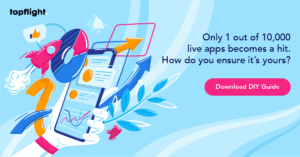It’ll cost around $250,000 to build a meditation app like Calm or Headspace. But what if you’re starting with a seed capital of $60,000, and you need a gem of a meditation app to begin paving your way for success?
Our experience says you need to start lean and work your way to investors and customers with a rapid prototype (RP) and minimum delightful product (MDP).
Get ready to learn how to create a meditation app that radiates value and brings genuine value to your customers. We’ll also explain how RP and MDP work and why you need both to succeed.
Table of Contents
- Step 1: Research Competition
- Step 2: Create a Prototype
- Step 3: Buil the App
- Step 4: Test and Fix Bugs
- Step 5: Deploy
- Step 6: Measure User Engagement
- How to Monetize a Meditation App
- How Much Does It Cost to Build a Meditation App?
- Best Practices in Meditation App Development
- Start Your Mindfulness App
To help you navigate the steps and process of building a successful meditation app, we’ve outlined the key phases and their essential actions in the table below.
| Step | Description |
|---|---|
| 1. Research Competition | Analyze top-performing meditation apps, user reviews, and market stats to identify unique features and opportunities. |
| 2. Create a Prototype | Develop low- and high-fidelity prototypes, test with users, and refine based on feedback for better design validation. |
| 3. Build | Code the app with features like social login, meditation sessions, reminders, and payment integration. Create a CMS for content management. |
| 4. Test | Perform functional and stress testing to ensure app reliability, user-friendliness, and optimal performance under load. |
| 5. Deploy | Submit the app to stores, ensure compliance with guidelines, and implement DevOps for efficient updates and maintenance. |
| 6. Measure User Engagement | Use analytics platforms to track user behavior, retention rates, and app stickiness to refine features and boost satisfaction. |
Step 1: Research Competition
Before you create an app for meditation, you need to understand your competition. In my opinion, there’s no better place for such research than mobile analytics platforms like App Annie or SensorTower. These solutions aggregate application rankings from mobile stores and publish top app charts by categories.
Mindfulness and meditation app market overview
If you check the top-ranking mediation solutions with one of these services, you’re likely to end up with these lists of trending mindfulness applications:
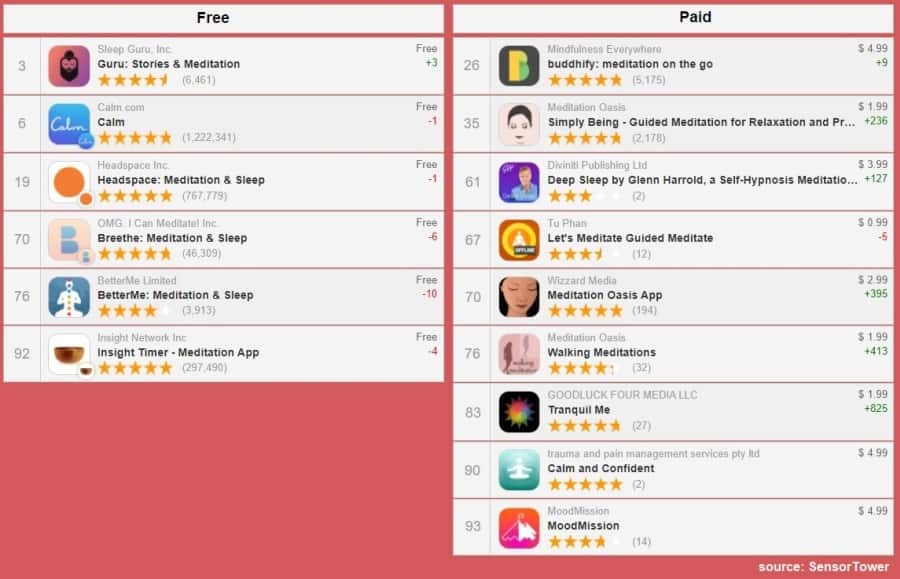
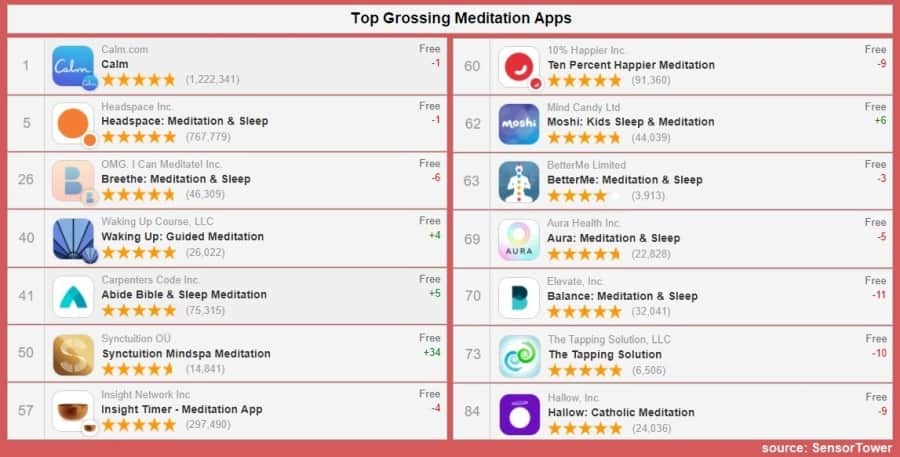
What can we take away from such charts:
- 14 of the top 100 top-grossing products in Health & Fitness are meditation apps
- Top-performing applications include Guru, Breathe, buddhify, Headspace, and Calm
- Leading and aspiring meditation apps churn in from $5K to $5M per month

I’d encourage you to dive deeper into user reviews for all of these applications that have made it into the top 100. You’ll definitely discover gems that will help you come up with a better product. Check out this user’s gripe in a review on the Calm meditation app:

Economics of mindfulness applications
As you can imagine, the economics of mindfulness apps is pretty impressive. The COVID-19 pandemic has brought these self-help applications to the top of the mobile stores as many of us agree to shell out for consolation and stress relief.
Here are just a few stats in favor of investing in meditation app development:
- Meditation market is estimated at 1.2b and is expected to grow to 2b by 2022
- Mobile stores have welcomed more than 2,500 meditation apps since 2015
- Calm is valued at $2b and makes between $150m and $200m per year
Finding your USP
Of course, you can’t compete with 2,500+ applications for meditation without spicing your product with a mojo. What makes meditation apps unique besides content? I suggest looking into the latest mobile tech or finding ways to blend larger mobile trends with your solution’s advanced features.
Consider these ideas as prompts to start your creative juices flowing:
- bet on social: unlock premium content in exchange for invited (and engaged) friends or allow users to record their own meditations for their friends (heck, you can be a marketplace for such self-made meditations)
- use augmented reality or virtual reality to create more immersive experiences
- rethink gamification: would you really download a meditation application to compete or gain virtual rewards?
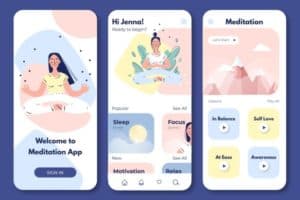
Step 2: Create a Prototype
The next big step in building a meditation app is crafting a prototype. At Topflight, we use a time-proven, well-formalized routine we call Rapid Prototyping. This procedure involves several UX/UI design iterations with a different level of fidelity.
Wireframing
Creating the most basic wireframes, a blueprint of your future app, is how you start fleshing out an idea. The main goal at this stage is to create the basic visual architecture of the solution. This simply means low-fidelity sketching main screens that users will interact with most.
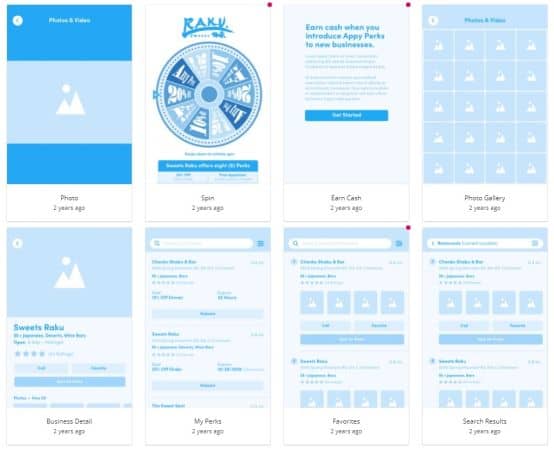
High-fidelity prototype
Once the wireframes are ready, it’s safe to transition to high-fidelity designs and interconnect all screens by linking buttons and other UI/UX elements with corresponding screens. In the end, you should have a graphical representation of the application, implemented as a clickable prototype with basic animations. It may look like a nearly finished product on the surface with zero code beneath.
Related: Using Figma for Rapid Prototyping, Wireframes and Mockups
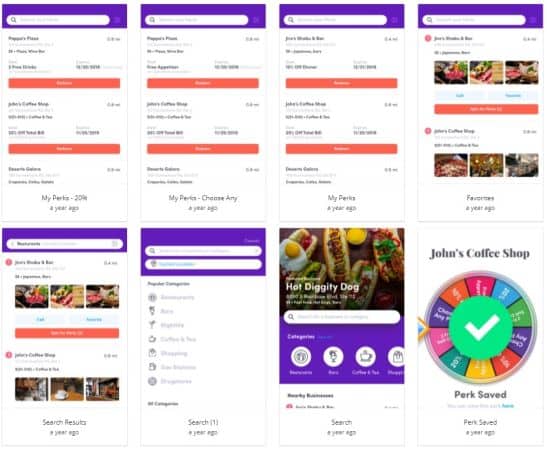
User testing
The only reason to create a prototype like that is to test your meditation app design and flow with real users and augment it based on their feedback. There are various platforms out there like UserTesting that can help with user testing your app and its features.
If you’re starting lean and want to create an app like Headspace, this rapid prototyping procedure will save your budget. With a prototype, you get to verify your idea without investing a fortune into coding — the most cost-heavy part of the app development process.
The rapid prototyping approach guarantees that you can develop a meditation app that will generate some real traction.
Tips for prototyping a mindfulness app:
- involve developers early on to get advice on the technical feasibility of a prototype
- carefully consider the color palette, opting for calming visuals
- validate the prototype by testing it with users from your target audience

Step 3: Build
When you have a validated prototype, it’s time to create a mindfulness app. For the most part, this stage involves developers coding various app features and tying them all together into a cohesive experience.
Develop a mobile solution
Needless to say, the core piece of your mindfulness solution will be a mobile application. Therefore, you start a meditation app by coding an iOS or Android application.
First and foremost, you will need to pick a tech stack for developing the mobile app. We recommend Swift for an iPhone application and Kotlin for Android. Alternatively, you can choose React Native and build a cross-platform solution.
We also recommend applying trusted third-party libraries and SDKs to shortcut the development of such features as a live chat, push notifications, user authentication, and other typical options.
Here’s a list of top features that users have come to expect from a meditation product:
- Social Login
Depending on the platform you’re targeting, you can choose between Apple/Google ID or select something more general like a Facebook login. The only reason to authorize users is to personalize their experience as much as possible.
If you plan to develop a meditation application agnostic of the users’ sex, age, and other demographics, consider leaving out registration entirely. That will only work towards faster onboarding.
- User Profile
The user profile has to do with personalization. That’s where customers will see their favorite meditations, previous sessions, personal notes, and everything else you can come up with to reinforce their experience and make it unique and is, therefore, an important part of developing any healthcare application.
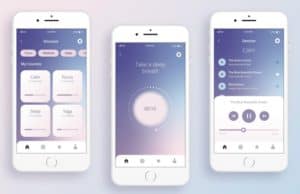
- Meditation Sessions
Meditations are going to be the meat and potatoes of your application, of course. Having enough content at the start will be crucial to your app’s stickiness.
- Search
Ideally, users don’t need to search for a preferable meditation session and rely on machine learning algorithms pushing the best-fitting content to them instead. On the other hand, having a non-intrusive way to filter sessions by various criteria wouldn’t hurt either.
- Reminders and Notifications
To keep users engaged, it’s a good rule of thumb to implement a reasonable strategy for reminders and notifications helping users get into the habit of meditating every day.
- Payments
This block of your product will be responsible for in-app purchases and paid subscriptions to unlock premium content. After all, you’re making a meditation app to make money.
Develop an admin console
When you build an app like Calm, the mobile application itself is only part of the story. The other critical element is developing a content management system (CMS) for managing the app’s content.
You’d want a web-based CMS for adding new meditation sessions, relaxation exercises, and all other materials your customer will be coming for. Fortunately, your users won’t be interacting with the CMS, so you can save on its design considerably.
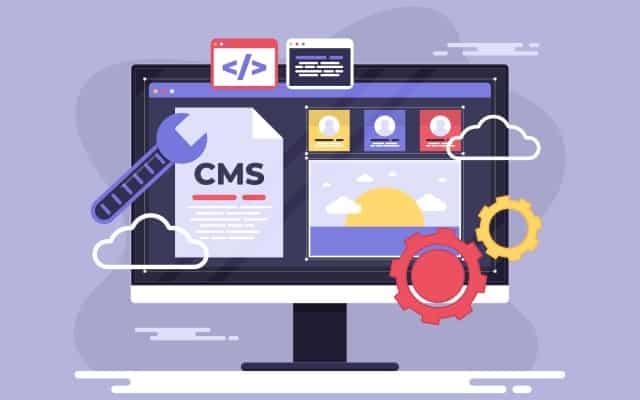
Focus on Minimum Delightful Product
While mindfulness app development is pretty exciting, you should stay focused on creating a minimum delightful product throughout the entire process.
What is an MDP? Plainly speaking, it’s an initial version of your meditation solution that will delight customers enough to create a sticking experience. Unlike a minimum viable product (MVP), an MDP focuses on the user experience and highlights its importance to the overall product’s success.
Following an MDP route does not imply stuffing your initial version of the app with tons of features. In fact, it’s quite the opposite. We suggest that you stick with one-two key features and execute them brilliantly from the technology and design perspectives.
Tips on how to create an app for meditation:
- remember that you’re building an app MVP (or MDP) that helps users solve concrete problems
- make use of time-proven third-party SDKs to shortcut some features development
- choose a customizable CMS to avoid developing an admin application from scratch
Step 4: Test
Frankly, when working with an app development team with strong project management skills, testing occurs at every stage of meditation app development, including prototyping and coding.
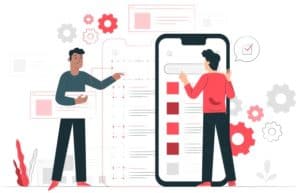
However, you need to run somewhat different tests once the app has been built. After all this sweat and blood, you’re finally nearing opening up the product to the public, and you need its top performance to engage new users.
At the minimum, you will need to run functional and stress tests before releasing your mindfulness product out in the wild.
Functional testing
With functional tests, you double-check that all app features work correctly and there are no significant bugs that crash the app. The key here is repetition and persistence. What often happens is fixes to found issues bring some new problems.
Therefore, it’s recommended that you stack up bugs and fix them all together before going into another round of testing. Furthermore, you should check all functionality end-to-end every time there’s a new fix.
A well-designed meditation app starts with customized mobile app development to ensure ease of use and a calming experience, focusing on user-friendly interfaces and intuitive navigation.
Stress testing
Stress testing is different from functional tests in a way that it puts your app performance to the extreme. Will it slow down or quit working when too many users log in? How many sessions can be streamed or downloaded per minute? Do all users get notifications based on their settings?

These are the kind of questions you’re looking to answer with stress testing. And remember, it’s alright if your mobile product crashes during tests. That’s exactly why they exist — to prevent your app from malfunctioning after the release.
Tips on how to test a mindfulness application:
- scrupulously check edge cases (e.g., no internet connection or one-handed usage)
- ask for feedback from the users who played with the prototype
- use services like App Live to test on multiple devices with different OS versions
Step 5: Deploy
Preparing a meditation application for a public release may look too simplistic: add the app to the mobile stores (after all, Apple and Google have the tutorials), and you’re done. Right? Not exactly.
Adding an app to the App Store and Google Play is not always as straightforward as you’d expect. Not only do you need to comply with Apple’s and Google’s developer guidelines, but you should also align your monetization model with their requirements.
Then, besides adding mobile apps to the stores, you need to switch your CMS platform to a production environment optimized to handle the surge of new users.

Finally, you need to implement DevOps infrastructure to ensure seamless development and testing of new app features as your product continues to grow.
Tips for deploying an app for meditation:
- set up DevOps to save time when releasing future app updates
- prepare a test environment that mimics your live app setup
- align your monetization strategy with the App Store and Google Play’s requirements
Step 6: Measure User Engagement
Post-launch, you will need to meticulously track user engagement to understand where you can improve your product. It’s almost the same as keeping tabs on a website users’ experience, only inside a mobile application.
Some of the user experience traits you’d want to track include:
- What are the most popular paths that users take inside the app?
- Are there any roadblocks that prevent them from taking action?
- How long does it take them to reach a goal?
Besides, there are also more economic KPIs like:
- retention and churn rates
- app stickiness
- average revenue per user (ARPU)
Note that even though you start measuring user engagement after you make a mindfulness app, the groundwork for this should take place during the app development process.
All you need to do is choose a mobile analytics platform and ask your development company to add its SDK to the app. As a result, you’ll be able to track all relevant app usage stats in a dashboard provided by the analytics solution.
Tips for tracking essential app KPIs:
- pick a service like Mobile Google Analytics or Flurry and add its SDK to your product
- set clear-cut goals that customers can reach by using the app
7. How to Monetize a Meditation App
The only two app monetization options worth talking about are subscriptions and in-app purchases. Most successful mobile apps use either one or a combination of both of these methods.
A pay-to-download strategy may put off early adopters, who could help spread the word while the application is still fresh in mobile stores. On top of that, you’d have to figure out how to charge for any new content: either release separate versions of the app or implement in-app purchases.
On the other hand, a renewable subscription allows you to establish a more predictable revenue stream, and you can always use an in-app currency for selling something extra.
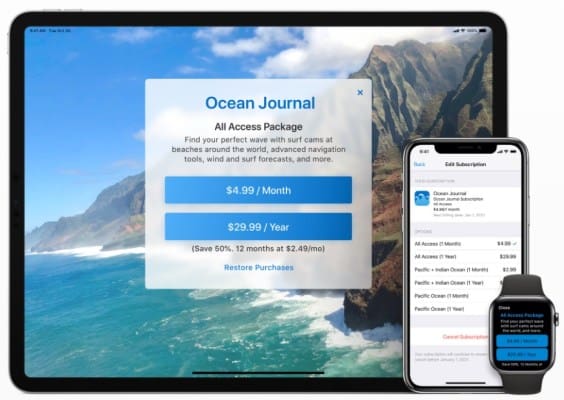
That said, you should absolutely check that your meditation app developers use the latest version of Apple’s StoreKit APIs. The company has recently updated its subscriptions, making them more transparent and appealing to consumers.
Tips for monetizing a meditation solution:
- go with a subscription model combined with in-app purchases
- use the latest versions of Google Play Billing Library and Apple’s StoreKit
- offer more than one variant of subscription and enable a free trial period
- in-app purchases may work for selling bonus content
8. How Much Does It Cost to Build a Meditation App?
As mentioned in the intro, the app development cost of a Calm or Headspace replica can easily wind up at $250,000. However, crafting a rapid prototype and packing the most essential features into a minimum delightful product may well fit within a $80,000-$100,000 development budget.

The prototype will take around $20,000, a mobile application will require $35,000, and a CMS will take $15,000. Get in touch to learn more about the meditation app development cost.
Tips for optimizing the cost of mindfulness app development:
- start by validating your mobile product with rapid prototyping
- focus on building an MDP rather than a robust solution
- use open-source technologies to shortcut the development of boilerplate features
9. Best Practices in Meditation App Development
Let me share a couple more tricks that will help your mobile meditation app stand out.
Personalize user experience
Make the user experience personal from the very start. You can use onboarding to learn about your customers’ goals and fetch them the best matching content.
When they first launch the app, ask what they are looking to achieve here and present the content accordingly, surfacing the most relevant meditations or goods. Another way to add personalization is to allow users to rate meditations to offer content based on user reviews.
Add e-commerce to sell physical goods
I haven’t seen too many mobile apps that offer any meditation-related physical goods. And if you want to really take it up a notch, you can integrate your app with some wellness IoT products like smart pillows.
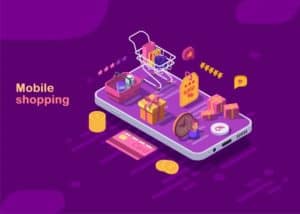
Include mood tracking
Wouldn’t it be great if your customers could easily mark their emotional state and then see how meditating practice influences their mental health. Remember, the more personal data they associate with the app, the stronger becomes their connection to your product.
Diversify in-app materials
As your solution continues to grow, it may start appealing to a massive audience. So make sure there’s enough to take away for everybody:
- morning meditations & breathing exercises
- mindfulness meditations
- sleep meditation & basic yoga moves
- attention training activities
- music for users to relax and relieve anxiety
Related: Sleep Tracking App Development
Implement smart notifications and reminders
Everybody is different: some like pure meditation sessions, others prefer guided meditation or sleep stories. Needless to say, these sessions happen at different times for all users.
Therefore, it wouldn’t be wise to rely on general notifications that trigger at specific times for everybody. Ideally, each user should be able to opt in for custom reminders besides getting more general push notifications.
Smartwatch companion app
Consider creating a separate companion app for a smartwatch. It looks like an ideal solution for brief on-the-go meditations. You could also use an Apple Watch app to show users stats on their progress.

Chatbot
Some customers will absolutely appreciate an AI-enabled chatbot to guide them towards the most suitable meditation practices or answer their questions about the app. It’s worth noting that if you include a chatbot, there should be an option to revert to a human conversation for cases when the bot gets stuck.
Related: Complete Guide to Building a Chabot
Make the content available offline
This may seem like a trifle option when you create your own meditation app, but it can be a real deal-breaker for users who live in areas with poor internet connectivity. Don’t worry about users abusing downloaded materials by using them outside the app. The iOS platform does a great job at making these files available only in your mobile product.
Take advantage of the latest features in a mobile OS
You’d be surprised, but even the most popular meditation applications (e.g., Calm or Insight Timer) miss that. For example, starting with Android 11, you can add a seek bar to a notification (beneath the play button) to quickly jump to any track point.

Let’s say you need to rewind a session a few minutes: with this latest Android 11 feature, you can do this right from a notification plate.
For iOS, consider adding an app clip that will immerse your prospects into a brief intro meditation wherever they are just by scanning a QR code.
10. How Topflight Can Help You with Meditation Mobile App Development
One of the interesing meditation apps we’ve built recently introduces an exciting take on the practice of meditation. Respirosa helps customers practice breathwork while listening to their favorite music and following visual clues synced to the beat. Users pick a tune by mood, genre, or artist and choose a color theme. The app then plays the song in Spotify and guides users through breathing sessions with an animation adjusted to the tempo.
- Integration with Spotify APIs
- Firebase for managing the music collection
- Breathwork animation synced to the beat
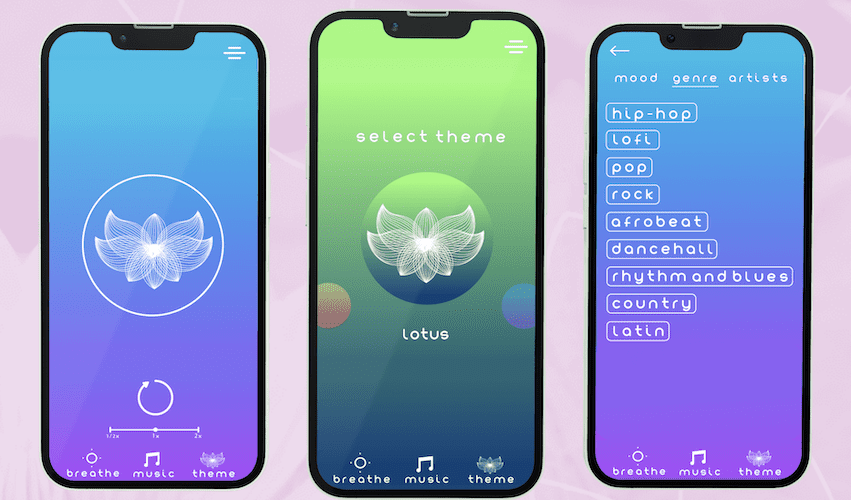
If you have some questions about how to make a meditation app, schedule a call to discuss your concept with one of our experts. Actionable advice guaranteed. As you now know, meditation mobile app development poses quite a few challenges, and we’ll be happy to help you take them on one by one.
Related Articles:
- How to make a yoga application
- Mental Health App Development Guide
- Fitness App Development Guide
- Healthcare App Development Guide
- How to create a telehealth application
- Wearable App Development Guide
- Build a Mental Health Chatbot
[This blog was originally published in 5/28/2022 and has been updated for more recent content]
Frequently Asked Questions
Do you know any mindfullness apps that are doing well with a pay-to-download strategy?
Buddhify sells at $4.99 and generates about $10,000 per month on the App Store and about $5,000 on Google Play. It’s the best-performing mindfulness app in the paid category.
What SDKs would you recommend to speed up the development of mainstream app features?
Twilio or Sendbird for a chat, Firebase for push notifications, Facebook or Google for registration. Schedule a call to get more information about other solutions we recommend and use for quickly adding boilerplate features.
What technology should I be aware of if I plan to build a meditation app with live video sessions?
Twilio and Agora.io are great options to implement video streaming in your meditation solution.
What additional features can I use on iOS to make my product stand out from other mindfulness applications?
Deep Siri (aka Siri shortcuts) and Spotlight Search integration will help you surface your app’s content outside the application.
Is it a good idea to allow sharing some of the application content on social media?
That’s totally up to you, but I believe meditation and its fruits are very personal. Would you share anything from your Calm or Headspace experiences?
How long does it take to create a meditation app like Calm or Headspace?
Somewhere between four and six months.

